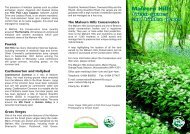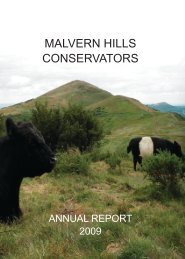Footpath degradation of the Malvern Hills - Malvern Hills Conservators
Footpath degradation of the Malvern Hills - Malvern Hills Conservators
Footpath degradation of the Malvern Hills - Malvern Hills Conservators
You also want an ePaper? Increase the reach of your titles
YUMPU automatically turns print PDFs into web optimized ePapers that Google loves.
Stephen Britnell<br />
<strong>Footpath</strong> <strong>degradation</strong> <strong>of</strong> <strong>the</strong> <strong>Malvern</strong> <strong>Hills</strong><br />
topographic maps. This was not an effective method , so field observations, photos, and air<br />
photos were used. Through this second method it was concluded that actual path density was<br />
nine times than what was originally estimated. Harden’s 1992 work clearly shows a<br />
continuing need to identify actual processes and <strong>the</strong>ir controls over path erosion, and to<br />
establish <strong>the</strong>ir importance at various scales <strong>of</strong> watershed analysis.<br />
Grieve et al. (1995) nature and extent and severity <strong>of</strong> soil erosion in upland Scotland,<br />
examines erosion via <strong>the</strong> use <strong>of</strong> aerial photographs. The main conclusion from this paper<br />
regarding footpath erosion is that <strong>the</strong> broad technique <strong>of</strong> using aerial photographs is not<br />
appropriate. This is because Grieve et al. (1995) found that footpaths were difficult to identify<br />
and quantify, especially at lower altitudes. Conclusion drawn from <strong>the</strong> studies <strong>of</strong> Harden<br />
(1992) and Grieve et al. (1995) is that studies <strong>of</strong> path erosion must be carried out by way <strong>of</strong><br />
first hand field studies.<br />
1.2.2 Controls over recreational pressures<br />
The aims <strong>of</strong> Zinng’s (1940) experiments were to produce an equation quantifying <strong>the</strong><br />
effect <strong>of</strong> land slope and length has on soil loss, with <strong>the</strong> respect to one variable, run<strong>of</strong>f. This<br />
equation is primarily for use in agricultural studies and does not take into account recreational<br />
pressures that are experienced along footpath slopes.<br />
The main findings <strong>of</strong> Zingg (1940) are that 1) doubling <strong>the</strong> degree <strong>of</strong> slope increased<br />
<strong>the</strong> total soil loss in run<strong>of</strong>f 2.80 times. 2) Doubling <strong>the</strong> horizontal lope length increases <strong>the</strong><br />
total soil loss in run<strong>of</strong>f 3.03 times. 3) increasing <strong>the</strong> degree <strong>of</strong> sloe increased <strong>the</strong> total run<strong>of</strong>f.<br />
4) Increasing <strong>the</strong> length <strong>of</strong> slope decreased <strong>the</strong> total run<strong>of</strong>f. From <strong>the</strong>se findings and o<strong>the</strong>r<br />
statistical methods Zing (1940) developed this equation for soil loss in run<strong>of</strong>f:<br />
Figure 1: E=CS 1.4 L 1.6 Where: E = Total soil loss from a land slope <strong>of</strong> unit width<br />
C = a constant = 0.065<br />
S = Degree <strong>of</strong> land slope<br />
L = Horizontal length <strong>of</strong> land slope<br />
2





